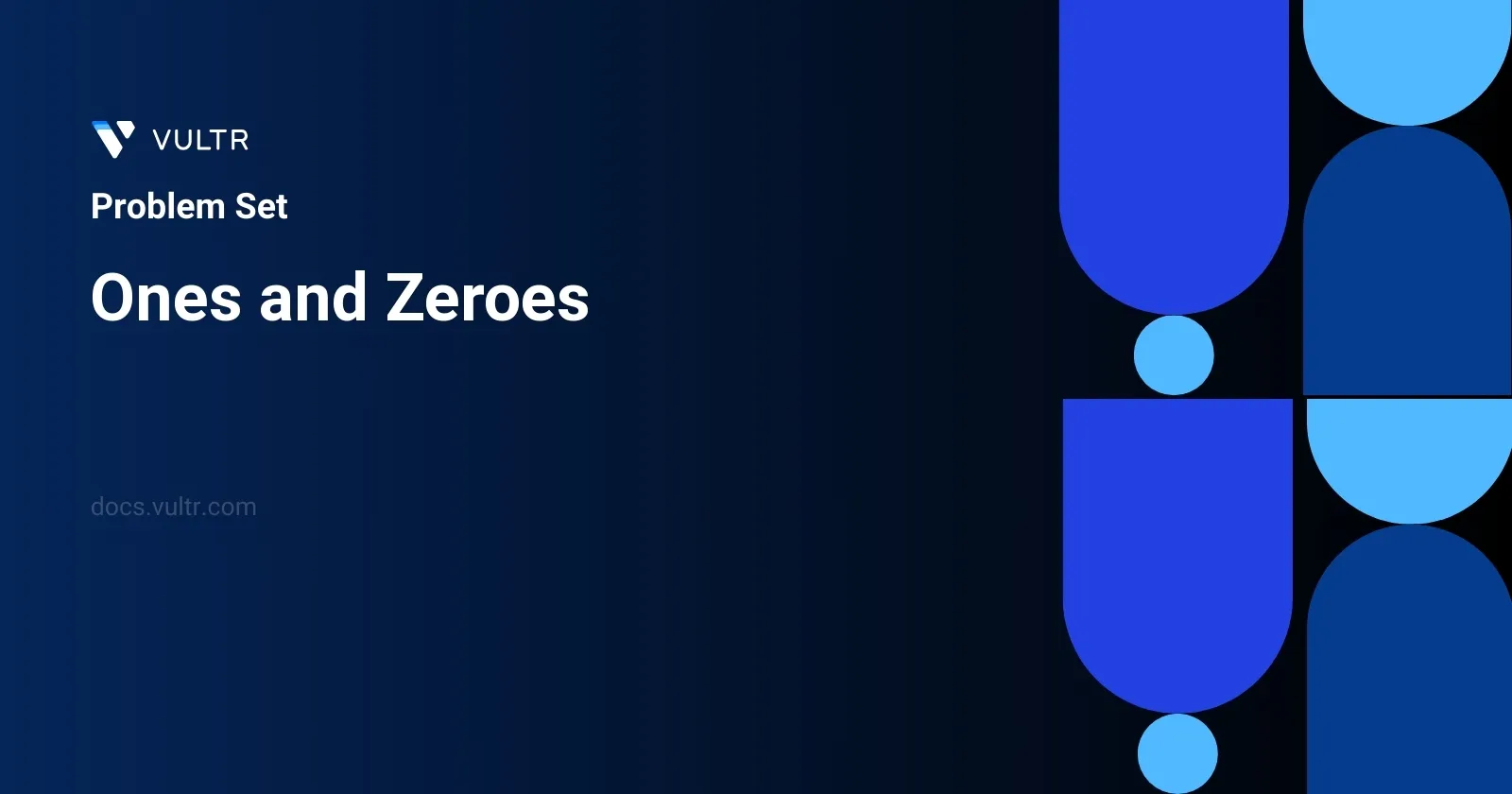
Problem Statement
In this problem, we are provided with an array of binary strings called strs along with two integers, m and n. Our goal is to derive the size of the largest subset from the array strs where the total count of the character '0' does not exceed m and the total count of the character '1' does not surpass n. It is crucial to note that a subset, in this context, means a collection of elements that are all found within the original array. The subset should follow the constraints set by m and n regarding the counts of '0's and '1's respectively.
Examples
Example 1
Input:
strs = ["10","0001","111001","1","0"], m = 5, n = 3
Output:
4
Explanation:
The largest subset with at most 5 0's and 3 1's is {"10", "0001", "1", "0"}, so the answer is 4.
Other valid but smaller subsets include {"0001", "1"} and {"10", "1", "0"}.
{"111001"} is an invalid subset because it contains 4 1's, greater than the maximum of 3.Example 2
Input:
strs = ["10","0","1"], m = 1, n = 1
Output:
2
**Explanation:** The largest subset is {"0", "1"}, so the answer is 2.Constraints
1 <= strs.length <= 6001 <= strs[i].length <= 100strs[i]consists only of digits'0'and'1'.1 <= m, n <= 100
Approach and Intuition
- The problem can be visualized as a variant of a multi-dimensional knapsack problem. Here, instead of weight, we have two constraints,
mandn, which represent the maximum allowable counts of '0's and '1's in the subset. - The key attributes to consider:
- The constraints of maximum numbers of
0s (m) and1s (n) in the subset. - The potential of each string in the array contributing to these constraints in varying degrees.
- The constraints of maximum numbers of
Counting Binary Strings: Start by evaluating each string in
strsto count how many0s and1s they contain. This will help us understand the "weight" each string carries against our limitationsmandn.Dynamic Programming (DP) Table Initiation:
- Create a DP table where
dp[i][j]represents the maximum size of the subset possible with at mostinumbers of0s andjnumbers of1s available.
- Create a DP table where
Filling Up The DP Table:
- Iterate through each string and update the DP table in a way to track the maximum size of the subset. For every string, update the table backwards (from
mto0andnto0) to make sure each string is only considered once in the subset. - For each string, count its zeros and ones. For each pair of
(i, j)in the DP table (whereiandjare current counts of allowed0s and1s): if adding the current string respects the limitations (i.e., doesn't exceed neithermnorn), update the DP value considering the inclusion of the current string.
- Iterate through each string and update the DP table in a way to track the maximum size of the subset. For every string, update the table backwards (from
Result Extraction:
- The value at
dp[m][n]will be your result, which indicates the size of the largest subset that fits the criteria.
- The value at
- Note:
- DP approach ensures that all potential combinations of strings are considered while respecting the limitations imposed by
mandn. This method is effective given the constraints, as direct computation for each possible subset would be computationally expensive given the input sizes.
- DP approach ensures that all potential combinations of strings are considered while respecting the limitations imposed by
By applying dynamic programming, this strategy avoids redundant recalculations and offers a systematic approach to building up solutions to larger problems based on solutions to subproblems.
Solutions
- Java
public class Solution {
public int calculateMaxForm(String[] strings, int m, int n) {
int[][] dpTable = new int[m + 1][n + 1];
for (String str: strings) {
int[] counts = getZeroesAndOnes(str);
for (int zeroCount = m; zeroCount >= counts[0]; zeroCount--)
for (int oneCount = n; oneCount >= counts[1]; oneCount--)
dpTable[zeroCount][oneCount] = Math.max(dpTable[zeroCount - counts[0]][oneCount - counts[1]] + 1, dpTable[zeroCount][oneCount]);
}
return dpTable[m][n];
}
public int[] getZeroesAndOnes(String s) {
int[] counter = new int[2];
for (int i = 0; i < s.length(); i++) {
counter[s.charAt(i)-'0']++;
}
return counter;
}
}
The code in Java provides an elegant solution for determining the maximum number of strings that can be formed using a specified number of 0s and 1s from an input array of binary strings. The function defined calculates the maximum form by utilizing dynamic programming.
- The
calculateMaxFormmethod initializes a dynamic programming tabledpTablewith dimensions(m+1) x (n+1), wheremandnare the maximum allowed count of0sand1srespectively. - Each string in the provided array is assessed for its count of
0sand1sby thegetZeroesAndOnesmethod, which counts these values and returns them in a two-element array. This method iterates through each character in the string, using the ASCII value offset to increment counts in the array. - The main loop of the
calculateMaxFormmethod updates thedpTableby iterating frommdown to the number of0sin the current string and fromndown to the number of1s. This backward iteration prevents the overwritten of states that are still needed. - For each cell in the
dpTable, the method calculates the maximum value by either taking the count from the previous state plus one (indicating the inclusion of the current string) or retaining the count from the existing state (excluding the current string). - The outcome or the maximum number of strings that can be formed is given by the value at
dpTable[m][n]at the end of the iteration process.
This solution effectively handles the optimization problem of maximizing the count of substrings within given constraints by leveraging the properties of dynamic programming to build upon previous computations, ensuring an efficient and scalable approach.